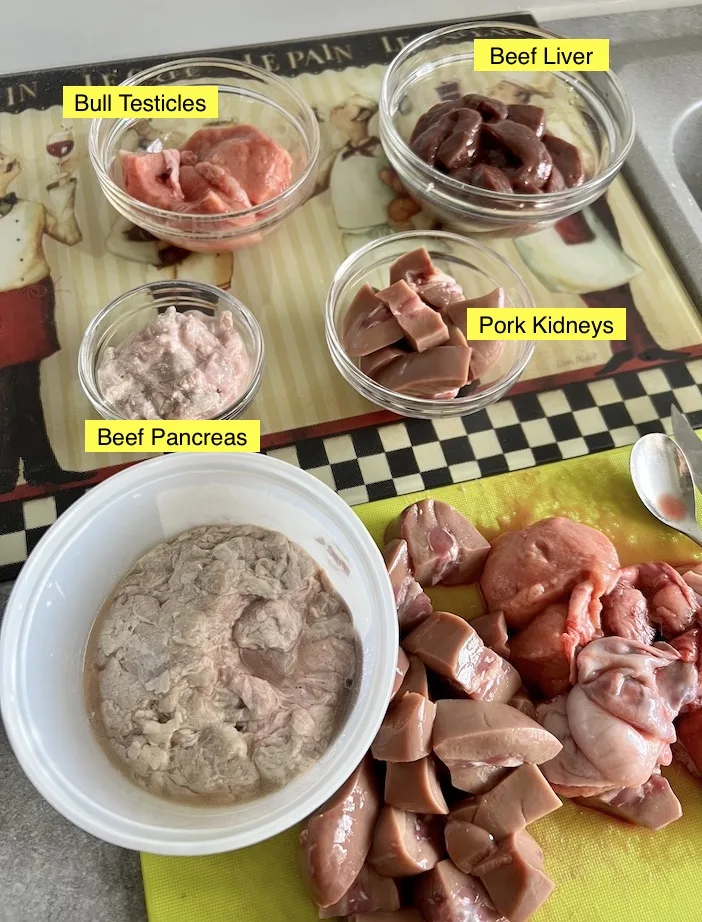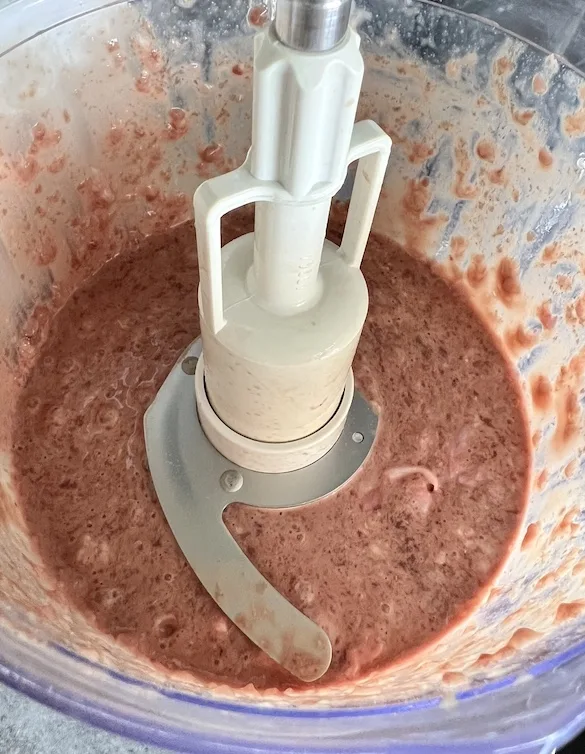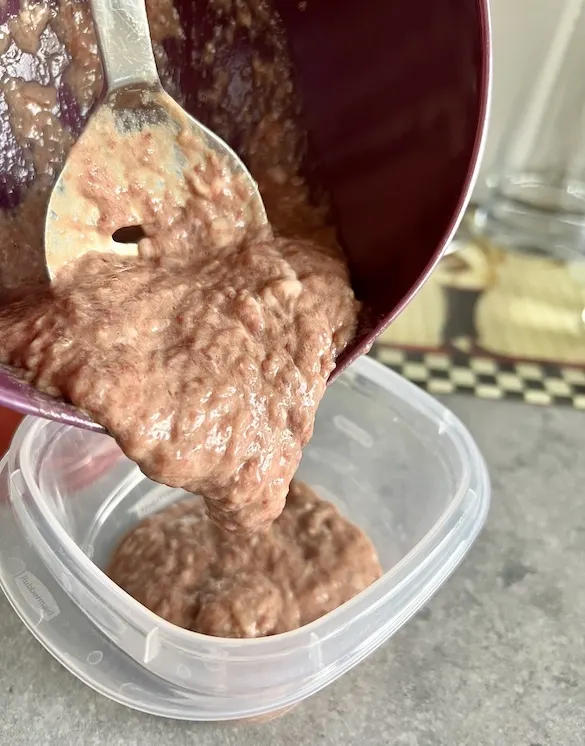If you’re confused about how to use secreting organ meat for dogs in raw feeding, this blog post is for you.
Besides sharing a secreting organ meat for dogs recipe you can use in your homemade raw dog food, I’ll also explain what secreting organs are and why raw-fed dogs need them.
And just in case you’re wondering what qualifies me to talk about secreting organ meat apart from being a raw dog food nerd, I’ve been making homemade raw dog food since 2015.
In 2020, I got my certification as a raw dog food nutrition specialist from Dogs Naturally Magazine, so I’ve learned a thing or two about secreting organs!
Ready? Let’s jump right in!
What Are Secreting Organs?
In raw feeding, all animal organs that secrete a substance are classified as secreting organs.
The best known secreting organ meat for dogs is probably liver, but there’s also:
- Kidney
- Spleen
- Pancreas
- Thymus gland
- Brains & eyes
- Reproductive organs
Pancreas and thymus gland are also often referred to as sweetbreads.
Non-secreting organ meats that are commonly confused with secreting cuts of organs are heart and lung.
Those belong to the muscle meat category in raw feeding, and you can feed up to 20% of your dog’s daily raw dog food allowance of each.
Why Do Dogs Need Secreting Organs?
The short answer is that secreting organ meat is chock full of valuable nutrients that other cuts of meat lack.
That’s why secreting organs like liver, kidney, spleen, brains, testicles, uterus and pancreas are considered Mother Nature’s multivitamins.
As such, they’re naturally rich in Vitamin A, B Vitamins, iron, zinc, selenium and other trace minerals.
Additionally, brains are also a wonderful source of Omega-3 fatty acids and pancreas is naturally rich in digestive enzymes.
Vitamin A helps support:
- A strong immune system
- Healthy skin and coat
- Proper vision
B Vitamins are a group of essential nutrients that play various important roles in your dog’s body.
They include:
- B1 (Thiamine). Helps convert food into energy and supports normal heart and nerve function.
- B2 (Riboflavin). Aids in energy production, growth, and maintenance of healthy skin and coat.
- B3 (Niacin). Plays a role in energy metabolism and helps maintain a healthy nervous system.
- B5 (Pantothenic acid). Essential for energy production and the formation of hormones and red blood cells.
- B6 (Pyridoxine). Supports brain development, the production of red blood cells, and the function of the immune system.
- B7 (Biotin). Contributes to healthy skin, coat, and nails, and helps metabolize carbohydrates, fats, and proteins.
- B9 (Folate). Necessary for the production of genetic material (DNA) and red blood cells.
- B12 (Cobalamin). Supports the nervous system, aids in the production of red blood cells, and helps with energy metabolism.
Iron is important for:
- Proper functioning of white blood cells
- Red blood cell production
- Growth and development
- Oxygen transport
Zinc is important for:
- Growth and development
- A strong immune system
- Skin and coat health
- Taste and appetite
- Enzyme function
Selenium is important for:
- Proper functioning of the thyroid
- Proper functioning of muscles
- A strong immune system
- Antioxidant protection
- Reproductive health
And you probably already know that digestive enzymes are important for gut health, and that Omega-3 fatty acids fight inflammation within the body.
So by feeding a large variety of secreting organ meats, raw feeders ensure there aren’t any nutritional holes in their dogs’ raw meals.
Nerd fact: Wild dogs and wolves who hunt their own prey instinctively eat the secreting organs first because they know what’s good for them!
How Much Secreting Organ Meat Do Dogs Need?
This depends on your dog’s age and activity level.
But generally speaking, moderately active adult dogs will need 10% of their daily raw dog food allowance to be secreting organ meat.
For example, a 50 lb adult dog who goes for 2 hour walks everyday needs 2 oz of secreting organ meat per day.
Here’s how to do the math:
Divide the dog’s body weight by 100, then multiply the result with 2.5%.
That gives you the dog’s daily raw dog food amount.
Good to know: The percentage is known as “maintenance percentage”.
For dogs who are at their target body weight, we calculate their raw dog food needs with a 2.5% maintenance percentage that ensures the dog stays at their current weight.
The daily raw dog food amount for dogs who need to lose weight is calculated at 1.5%-2%, and the percentage for working dogs and pregnant dogs can be as high as 4.5%.
But either way, here’s how you calculate how much raw dog food the 50 lb dog needs per day:
50/100 = 0.5 x 2.5% = 1.25 lb = 20 oz of daily raw dog food
Now, 10% of 20 oz is 2 oz, so that’s the dog’s daily secreting organ meat allowance.
One more caveat:
Half of those 10% needs to be liver, and the other half needs to be a different secreting organ such as:
- Kidneys
- Spleen
- Pancreas
- Brains
- Testicles
- Uterus
- Thymus gland
That means that the dog would need 1 oz of liver and 1 oz of another secreting organ on a daily basis.
So overall, dogs need very little secreting organs in their daily diet, but they’re still an essential component of balanced raw dog food.
For information on how much raw dog food puppies need to eat, read our puppy blog post here.
Secreting Organ Meat For Dogs Recipe
OK, now it’s time for some kitchen fun!
Besides the ingredients listed below, you’ll also need a food processor that grinds the secreting organ meat into a purée.
That’s the easiest way to ensure that your pup gets equal amounts of the secreting organ meats.
Here’s what you’ll need for this particular recipe:
- 8 oz liver, rich in Vitamin A
- 4 oz kidney, rich in B Vitamins
- 2 oz testicles, rich in B Vitamins
- 2 oz pancreas, rich in digestive enzymes
Secreting organ meat for dogs – recipe ingredients
That’s a total of 16 oz = 1 lb. Remember, adult dogs need only 10% of their daily raw dog food allowance of this mix.
The animal you get the cuts of meat from doesn’t really matter because you should rotate your dog’s protein sources either way.
So for example, you can switch it up between chicken liver, beef liver, rabbit liver and pork liver.
Rotate between beef kidney, pork kidney and rabbit kidneys.
Buy beef pancreas one month and pork pancreas the next.
Get any testicles you can. Those are a bit tricker to source and you’re usually limited to either bull or goat testicles.
If you can also get your hands on secreting organs from ducks and deer, do it.
You get the idea.
I used mostly beef (liver, testicles, pancreas) as the main protein source for this batch of secreting organs except for the kidneys which are pork kidneys.
When you’ve cut up and measured out your ingredients, combine them in your food processor and mash them up.
Once you’ve made your secreting organ meat mix, you can either use it right away for raw dog food meal prep or store it inside a food storage container in the freezer for later.
Ready to purée the secreting organ meats
Puréed secreting organ meat blend
Transferring the secreting organ meat blend into a food storage container
Where To Buy Secreting Organ Meat For Dogs
I got the beef liver and pork kidneys from a local grocery store, and bought the beef pancreas and bull testicles from an online raw dog food retailer.
Now, regardless of where you’re located in the US, you should at least find chicken liver in any local grocery store. As a matter of fact, many also carry beef and calf liver.
For other cuts of organ meat like kidneys, pancreas and testicles, you probably won’t get lucky at a regular grocery store.
But Ethnic grocery stores such as Asian supermarkets are known to carry those “odd” cuts of meat, and butchers and farmers are often willing to part with them too.
During deer hunting season, see about making friends with hunters and/or wildlife processors to get your hands on some fresh secreting organs.
Note: You’ll want to freeze any cuts of meat from wildlife for 3 weeks prior to feeding it to your dog. That ensures that any potential parasites are killed off.
For more ideas on where to buy raw organ meat for dogs, check out our blog post here.
Bottom Line
I hope you’ll have fun making this secreting organ meat recipe in multiple variations!
Remember, secreting organs are the most nutrient rich parts of animals.
They contain high levels of essential vitamins and minerals that are vital for a dog’s overall health and well-being.
That’s why it’s important to feed as many different cuts of secreting organ meat as possible, and to rotate your protein sources.
That way, you’ll ensure that your dog’s raw meals won’t have any nutrient holes.
In raw feeding, secreting organ meat makes up 10% of your adult dog’s daily raw dog food allowance.
When you break it down, 5% should be liver and 5% should be another secreting organ.
For example, kidney, spleen, pancreas, brains, eyes or reproductive organs.
So when you get ready to make your secreting organ batches for raw meal prep, you can really get creative with your ingredients.
For more information on raw feeding and 10 raw dog food recipes, check out Lindsay’s raw dog food ebook here.
She’s the founder of ThatMutt and a fellow raw feeder.
If you have any questions regarding secreting organ meat for dogs that weren’t covered in this blog post, please ask them in the comment section below!







Janie
Thursday 11th of January 2024
the raw food I’m not knocking it but seems faddish. Most dogs prefer cooked fresh food if given a choice. We once ate raw food. There are benefits to raw and cooked food. I use dog food supplemented with real food. Haven’t seen any studies showing what dogs live longest based on diet.
Janie
Thursday 11th of January 2024
The raw food I’m mpt